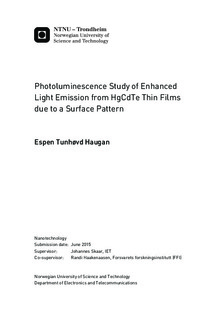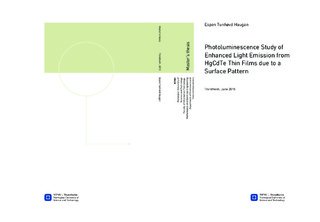| dc.description.abstract | HgCdTe thin film samples with a CdTe passivation layer have been grown by molecular beam epitaxy, and photolithography has been used to etch a triangular pattern of holes into the passivation layer. The enhancement in light emission from the samples due to their surface pattern has been measured by means of photoluminescence spectroscopy (PL), giving values ranging from 31 % to 163 %.
PL-measurements and simulations with both the transfer matrix method and the 3D finite-difference time domain (FDTD)-method have been used to investigate how the enhancement in light emission due to the surface pattern and the light extraction efficiency varies due to the sample parameters.
Different grating periods of the surface pattern, with a lattice constant to the wavelength ratio from 0.8-1.6, have been tested, where the enhancement in light emission for a grating period of 0.8-1.4 seems to be sample dependent, but fairly constant, while a larger grating period gives a lower enhancement.
It has also been studied how the light extraction efficiency of the samples depends on the depth of the holes, showing that for an emitted vacuum wavelength of about 4.6 micrometer, the holes should be at least 600 nm deep and etched all the way through the passivation layer of the structure.
PL-measurements also showed that there was no difference in the enhancement in light emission when the sample holder was tilted 21 degree, so that the detector covered a solid angle centered around 21 degree relative to the surface normal of the sample.
As both samples with and without a backside distributed Bragg reflector (DBR) were studied, the PL-measurements and simulations showed the effects of adding a DBR to the structure. It appears to increase the enhancement in light emission, but samples with a DBR also emit a broader range of wavelengths. When it comes to the absolute intensity emitted, the experiments and simulations give ambiguous results regarding the effect of the DBR. | |

